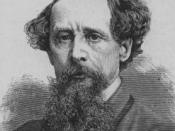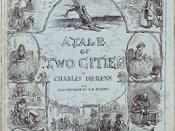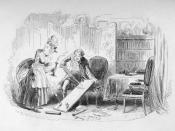In the novel A Tale of Two Cities, Charles Dickens uses satire in a variety of ways to make a political and personal statement. Two ways that are the most prominent methods he uses are pathos and irony. He uses ironic metaphors and situational irony.
With the depiction of a broken wine cask outside Defarge?s wine shop, and with his portrayal of the passing peasants? scrambling to lap up the spilling wine, Dickens creates a symbol of desperate quality of life and the people?s hunger, ?All the people within reach has suspended their business, or their idleness, to run to the spot and drink the wine? (36). Dickens creates a pathetic scene, ?Men and women, dipped in the puddles with little mugs of mutilated earthenware, or even with handkerchiefs from woman?s heads, which were squeezed into infants? mouths; others made small mud embankments, to stem the wine as it ran? (37).
The hunger is both literal hunger for food and metaphorical hunger for political freedoms. Pathos is just one of the ways Dickens uses satire in A Tale of Two Cities.
The second way Dickens uses satire is by the use of Irony. One of the most obvious ironic metaphors is Madame Defarge?s knitting. It is very symbolic. In her stitching she stitches a registry of all those condemned to die in the name of a new republic. Many peasants fear Madame Defarge. Madame Defrage is described as dark and wicked, this is obvious when Dickens says she passed, ?Like a shadow over the white road? (210). Through Madame Defarge, Dickens can make his own personal statement that he does not agree with vengeance. He does this by describing Madame Defarge the way he does. He shows his view of the revolution in the final chapter and...


